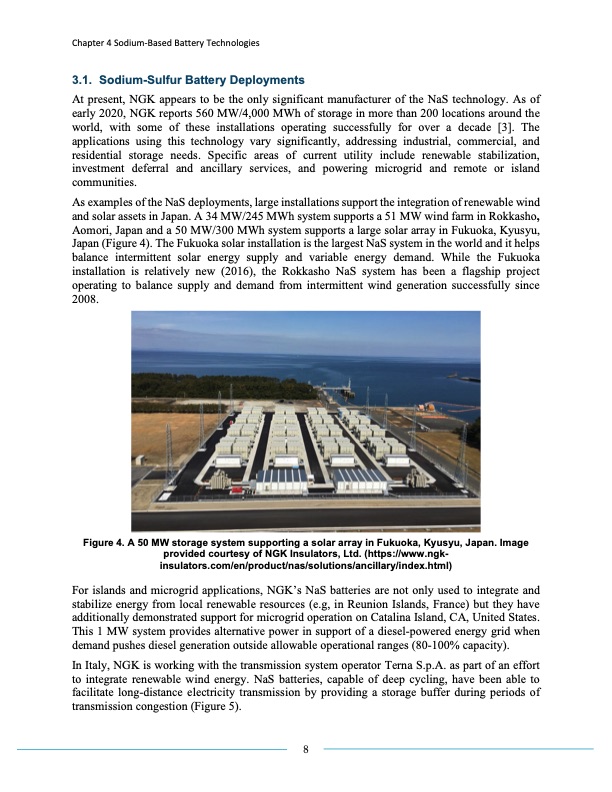
PDF Publication Title:
Text from PDF Page: 008
Chapter 4 Sodium-Based Battery Technologies 3.1. Sodium-Sulfur Battery Deployments At present, NGK appears to be the only significant manufacturer of the NaS technology. As of early 2020, NGK reports 560 MW/4,000 MWh of storage in more than 200 locations around the world, with some of these installations operating successfully for over a decade [3]. The applications using this technology vary significantly, addressing industrial, commercial, and residential storage needs. Specific areas of current utility include renewable stabilization, investment deferral and ancillary services, and powering microgrid and remote or island communities. As examples of the NaS deployments, large installations support the integration of renewable wind and solar assets in Japan. A 34 MW/245 MWh system supports a 51 MW wind farm in Rokkasho, Aomori, Japan and a 50 MW/300 MWh system supports a large solar array in Fukuoka, Kyusyu, Japan (Figure 4). The Fukuoka solar installation is the largest NaS system in the world and it helps balance intermittent solar energy supply and variable energy demand. While the Fukuoka installation is relatively new (2016), the Rokkasho NaS system has been a flagship project operating to balance supply and demand from intermittent wind generation successfully since 2008. Figure 4. A 50 MW storage system supporting a solar array in Fukuoka, Kyusyu, Japan. Image provided courtesy of NGK Insulators, Ltd. (https://www.ngk- insulators.com/en/product/nas/solutions/ancillary/index.html) For islands and microgrid applications, NGK’s NaS batteries are not only used to integrate and stabilize energy from local renewable resources (e.g, in Reunion Islands, France) but they have additionally demonstrated support for microgrid operation on Catalina Island, CA, United States. This 1 MW system provides alternative power in support of a diesel-powered energy grid when demand pushes diesel generation outside allowable operational ranges (80-100% capacity). In Italy, NGK is working with the transmission system operator Terna S.p.A. as part of an effort to integrate renewable wind energy. NaS batteries, capable of deep cycling, have been able to facilitate long-distance electricity transmission by providing a storage buffer during periods of transmission congestion (Figure 5). 8PDF Image | SODIUM-BASED BATTERY TECHNOLOGIES CH 4

PDF Search Title:
SODIUM-BASED BATTERY TECHNOLOGIES CH 4Original File Name Searched:
ESHB_Ch4_Sodium_Spoerke-1.pdfDIY PDF Search: Google It | Yahoo | Bing
Salgenx Redox Flow Battery Technology: Salt water flow battery technology with low cost and great energy density that can be used for power storage and thermal storage. Let us de-risk your production using our license. Our aqueous flow battery is less cost than Tesla Megapack and available faster. Redox flow battery. No membrane needed like with Vanadium, or Bromine. Salgenx flow battery
| CONTACT TEL: 608-238-6001 Email: greg@salgenx.com | RSS | AMP |